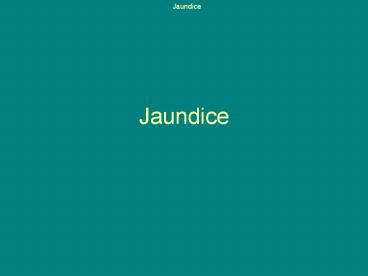Jaundice - PowerPoint PPT Presentation
1 / 15
Title:
Jaundice
Description:
Jaundice Bilirubin Metabolism Pre-hepatic Hepatic Post-hepatic Bilirubin Metabolism: Pre-Hepatic Bilirubin is formed in reticuloendothelial system as breakdown ... – PowerPoint PPT presentation
Number of Views:846
Avg rating:3.0/5.0
Title: Jaundice
1
Jaundice
2
Bilirubin Metabolism
- Pre-hepatic
- Hepatic
- Post-hepatic
3
Bilirubin Metabolism Pre-Hepatic
- Bilirubin is formed in reticuloendothelial system
as breakdown product of hemaglobin. - Heme group ? biliverdin ? bilirubin
- Bilirubin is insoluble in water, bound to
albumin. - Bilirubin circulates in the blood before uptake
by the liver. - Pre-hepatic jaundice if not taken up by the
liver/produced in excess, unconjugated bilirubin
is deposited in extra-hepatic tissues. - Kernicterus in newborns
4
Bilirubin Metabolism Hepatic
- Bilirubin is taken up into hepatocytes and
conjugated to glucuronic acid bilirubin
diglucuronide gt bilirubin monoglucuronide gt
secreted into bile - The glucuronide conjugated form of bilirubin is
water soluble and is excreted into bile. - Hepatic jaundice disorders of bilirubin uptake
or conjugation
5
Bilirubin Metabolism Post-Hepatic
- Glucuronide-conjugated bilirubin degraded to
urobilinogen. - Urobilinogen pathway
- may be reabsorbed by the gut and returned to the
liver - converted to urobilin gt reabsorbed into plasma
for excretion by kidneys - May be acted upon by bacterial enzymes within the
gut to form the bile pigment stercobilinogen gt
stercobilingtbrown color of feces - Obstructive jaundice failure of bilirubin to
reach the gut gt light colored stool, dark urine.
6
DDX
7
DDX Conjugated Hyperbilirubinemia
- Intrahepatic Cholestasis (impaired excretion)
- Functional, obstructive
- Hepatitis (viral, alcoholic, and non-alcoholic)
- Primary biliary cirrhosis or end-stage liver dz
- Sepsis and hypoperfusion states
- TPN
- Pregnancy
- Infiltrative disease TB, amyloid, sarcoid,
lymphoma - Drugs/toxins i.e. chlorpromazine, arsenic
- Post-op patient or post-organ transplantation
- Hepatic crisis in sickle cell disease
8
DDX Obstructive Jaundice
- Extrahepatic Cholestasis (obstructive jaundice)
- Choledocholithiasis
- Cancer/Neoplasm
- Pancreatic CA
- Cholangiocarcinoma (rare)
- Gallbladder CA
- Ampullary adenoma/adenocarcinoma
- Duodenal adenoma/adenocarcinoma
- Metastatic CA (and adenopathy of porta hepatis)
- Strictures after invasive procedures
- Acute and chronic pancreatitis
- Primary sclerosing cholangitis (PSC)
- Parasitic infections
9
Evaluation History
- Fever/chills, RUQ pain (cholangitis)
- Use of alcohol
- Hepatitis risk factors
- Inherited disorders including liver diseases and
hemolytic conditions - H/O blood transfusion
- TPN use
- H/O abdominal surgery
- Travel history
- Use of drugs or herbal medications
- Exposure to toxic substances
10
Evaluation PE
- Look for jaundice under tongue, conjunctiva,
skin (gt1.5mg/dL) - Signs of end stage liver disease (cirrhosis)
ascites, splenomegaly, spider angiomata, and
gynecomastia - Hyperpigmentation (hemochromatosis)
- Kayser-Fleischer ring (Wilsons disease)
- Courvoisiers sign painless, palpable/distended
gallbladder on exam (think of CA)
11
Evaluation Labs
- CBC infection, anemia
- LFTs
- Bilirubin (total/direct/indirect)
- AST, ALT (AST/ALT)
- Predominant increase in AST/ALT implies intrinsic
hepatocellular disease - Alk Phos, GGT
- ?Alk Phos also seen in sarcoid, TB, bone
- In this case, GGT is specific for biliary origin
- INR/albumin
- CA 19.9
- AFP
12
Evaluation Additional Labs
- Further specific labs.
- Serologic tests for viral hepatitis
- Antimitochondrial antibodies (for primary biliary
cirrhosis) - Anti-nuclear anti-smooth muscle (sm), and
liver-kidney microsomal (LKM) antibodies (for
autoimmune hepatitis) - Serum levels of iron, transferrin, and ferritin
(for hemochromatosis) - Serum levels of ceruloplasmin (for Wilson's
disease) - Measurement of alpha-1 antitrypsin activity (for
alpha-1 antitrypsin deficiency)
13
Imaging for Obstructive Jaundice
- RUQ U/S Stones, wall thickening, edema, CBD
diameter/obstruction - MRCP
- ERCP
- Direct visualization of biliary tree pancreatic
ducts - Procedure of choice for choledocholithiasis
- Diagnostic therapeutic
- PTC
- When ERCP not possible
- CT scan identification and description of
obstruction - Endoscopic U/S visualization of the common bile
duct without the hindrance of overlying bowel gas
14
Treatment
- Start with ABCs resuscitation
- If obstructive jaundice
- Ascending cholangitis IVF, ABX, decompression
(medical emergency) - Stones remove using ERCP or surgery
- Benign stricture stent vs. drainage catheter
- Cancer Stent vs. drainage /- resection of CA
- Primary goal decompression
15
Take Home Points
- Jaundice DDX is extensive
- DDX starting point pre-hepatic, hepatic,
post-hepatic - Obstructive jaundice choledocholithiasis,
tumors, PSC, pancreatitis, stricture, parasites - Ascending cholangitis is an emergency that must
be identified and treated promptly - Imaging U/S, EUS, CT, ERCP, MRCP
- Treatment of obstructive jaundice decompression































